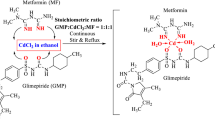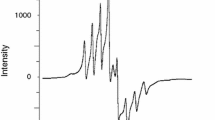Abstract
Complexes of [Mn(MF)2(Cl)2]·2H2O (1), [Fe(MF)2(Cl)2]Cl·4H2O (2), [Ni(MF·HCl)2(Cl)2]·6H2O (3), [Cu(MF·HCl)2(Cl)2] (4), [Zn(MF·HCl)2](NO3)2·6H2O (5), [Cd2(MF·HCl)(Cl)4(H2O)] (6), [Mg(MF·HCl)2(Cl)2]·6H2O (7), [Sr2(MF·HCl)(Cl)4(H2O)] (8), [Ba(MF·HCl)2(Cl)2]·2H2O (9), [Pt(MF)4] (10), [Au(MF)3]Cl3 (11), and [Pd(MF)2]Cl2 (12) were synthesized from Legitional behavior of metformin drug as a diabetic agent. The authenticity of the transition and non-transition metal complexes were characterized by elemental analyses, molar conductivity, (infrared, UV–Vis) spectra, effective magnetic moment in Bohr magnetons, electron spin resonance, thermal analysis, X-ray powder diffraction as well as scanning electron microscopy. Infrared spectral studies as well as elemental analyses revealed the existence of metformin in the base or hydrochloride salt forms in the chelation state acts as a bidentate ligand while the platinum(IV) complex is coordinated through the deprotonation of –NH group. The magnetic and electronic spectra of Mn(II), Fe(III), Ni(II), and Cu(II) complexes suggest an octahedral geometry. Antimicrobial screening of metformin and its complexes were determined against the (G+ and G−) bacteria (Escherichia coli, Staphylococcus aureus, Bacillus subtilis, and Pseudomonas aeruginosa) and fungi (Aspergillus flavus and Candida albicans).










Similar content being viewed by others
References
Stepensky D, Friedman M, Srour W, Raz I, Hoffman A. Preclinical evaluation of pharmacokinetic–pharmacodynamic rationale for oral CR metformin formulation. J Control Release. 2001;71:107–15.
Physicians. New Jersey: Desk Reference, Inc., Medical Economics Company; 2003, vol. 57.
The Merck Index. Published on CD by Chapman & Hall CRC. Whitehouse Station: Merck & Co Inc, Monograph No. 6001; 1999.
Damico C. Nursing, drug handbook. 22nd ed. Springhouse: Springhouse Publishers; 2002. p. 779.
Bailey CJ. The anti-hyperglycemic action of metformin. In: Krans HMJ, editor. Diabetes and metformin: a research and clinical update. Royal Society of Medicine international congress and symposium series, No. 79. London: Royal Society of Medicine; 1985. p. 17–26.
Hermann LS. Metformin: a review of its pharmacological properties and therapeutic use. Diabetes Metab. 1979;5(3):233–45.
Hermann LS. Metabolic effect of metformin in relation to clinical effects and side-effects. In: van der Kuy A, Hulst SGT, editors. Biguanide therapy today. Royal Society of Medicine international congress and symposium series, No. 48. London: Academic Press/Grune & Stratton; 1981. p. 17–48.
Lu LP, Zhang HM, Feng SS, Zhu ML. Two N,N-dimethylbiguanidium salts displaying double hydrogen bonds to the counter-ions. Acta Crystallogr C. 2004;60(10):o740–3.
Dolzhenko AV, Kotegov VP, Godina AT, Syropiatov BI, Kolotova NV, Koz’minykh VO. Hypoglycemic activity of substituted amides and hydrazides of succinic acid. Eksp Klin Farmakol. 2003;66(3):36–8.
Tucker GT, Casey C, Phillips PJ, Conner H, Ward JD, Woods HF. Metformin kinetics in healthy subjects and in patients with diabetes mellitus. Br J Clin Pharmacol. 1981;12(2):235–46.
Pentikainen PJ, Neovonen PJ, Pentilla A. Pharmacokinetics of metformin after intravenous and oral administration to man. Eur J Clin Pharm. 1979;16(3):195–202.
Sirtori CR, Franceschni G, Gallikienle M. Disposition of metformin (N,N-dimethylbiguanide) in man. Clin Pharm Ther. 1978;24(6):683–93.
Melander A, Wahlin-Boll E. Clinical pharmacology of oral antidiabetic agents. Acta Endocrinol Suppl. 1984;105(262):119–23.
Vigneri R, Goldfine ID. Role of metformin in treatment of diabetes mellitus. Diabetes Care. 1987;10(1):118–22.
Klepser TB, Kelly MW. Metformin hydrochloride: an antihyperglycemic agent. Am J Health Syst Pharm. 1997;54:893–903.
Bentefrit F, Morgant G, Viossat B, Leonce S, Guilbaud N, Pierre A, Atassi G, Dung NH. Synthesis and antitumor activity of the metformin platinum (IV) complex. Crystal structure of the tetrachloro(metformin)platinum (IV) dimethylsulfoxide solvate. J Inorg Biochem. 1997;68(1):53–9.
Viossat B, Tomas A, Nguyen-Huy D. L’hydrogénocarbonate de Bis(N,N-diméthylbiguanide) Cuivre(II), [Cu(C4H11N5)2]2HCO3. Acta Crystallogr. 1995;C51:213–5.
Lemoine P, Chiatdmi M, Bissery V, Tomas A, Viosssat B. Les composés de la metformine avec les ions CoII. CuII et NiII. Acta Crystallogr. 1996;C52(6):1430–6.
Zhu M, Lu L, Yang P, Jin X. Bis(1,1-dimethylbiguanido)copper(II) octahydrate. Acta Crystallogr. 2002;E58:m217–9.
Refat MS, El-Metwaly NM. Legitional behavior of 5,5-diethylbarbituric acid sodium salt (HL) towards Mg, Ca, Sr, Ba(II), spectral, thermal and biological studies. J Mol Struct. 2011;988(1–3):111–8.
Refat MS, Mohamed SF. Spectroscopic, thermal and antitumor investigations of sulfasalazine drug in situ complexation with alkaline earth metal ions. Spectrochim Acta A. 2011;82:108–17.
Refat MS. Synthesis, characterization, thermal and antimicrobial studies of diabetic drug models: complexes of vanadyl(II) sulfate with ascorbic acid (vitamin C), riboflavin (vitamin B2) and nicotinamide (vitamin B3). J Mol Struct. 2010;969:163–71.
Refat MS, El-Shazly SA. Identification of a new anti-diabetic agent by combining VOSO4 and vitamin E in a single molecule: studies on its spectral, thermal and pharmacological properties. Eur J Med Chem. 2010;45(7):3070–9.
Bauer AW, Kirby WM, Sherris C, Turck M. Antibiotic susceptibility testing by a standardized single disk method. Am J Clin Pathol. 1966;45(4):493–6.
Pfaller MA, Burmeister L, Bartlett MA, Rinaldi MG. Multicenter evaluation of four methods of yeast inoculum preparation. J Clin Microbiol. 1988;26(8):1437–41.
National Committee for Clinical Laboratory Standards. Performance vol. antimicrobial susceptibility of Flavobacteria; 1997.
National Committee for Clinical Laboratory Standards. Methods for dilution antimicrobial susceptibility tests for bacteria that grow aerobically. Approved Standard M7-A3. Villanova: National Committee for Clinical Laboratory Standards; 1993.
National Committee for Clinical Laboratory Standards. Reference method for broth dilution antifungal susceptibility testing of conidium-forming filamentous fungi: proposed standard M38-A. Wayne: NCCLS; 2002.
National Committee for Clinical Laboratory Standards. Methods for antifungal disk diffusion susceptibility testing of yeast: proposed guideline M44-P. Wayne: NCCLS; 2003.
Liebowitz LD, Ashbee HR, Evans EGV, Chong Y, Mallatova N, Zaidi M, Gibbs D. Global Antifungal Surveillance Group: a two years global evaluation of the susceptibility of Candida species to fluconazole by disk diffusion. Diagn Microbiol Infect Dis. 2001;4:27–33.
Matar MJ, Ostrosky-Zeichner L, Paetznick VL, Rodriguez JR, Chen E, Rex JH. Correlation between E-test, disk diffusion and microdilution methods for antifungal susceptibility testing of fluconazole and voriconazole. Antimicrob Agents Chemother. 2003;47:1647–51.
Geary WJ. The use of conductivity measurements in organic solvents for the characterisation of coordination compounds. Coord Chem Rev. 1971;7(1):81–122.
Refat MS. Synthesis and characterization of norfloxacin-transition metal complexes (group 11, IB): spectroscopic, thermal, kinetic measurements and biological activity. Spectrochim Acta A. 2007;68(5):1393–405.
Bellamy LJ. The infrared spectra of complex molecules. 3rd ed. London: Chapman and Hall; 1975.
Socrates G. Infrared characteristic group frequencies. 1st ed. New York: Wiley; 1980.
Shanmugam R, Sathyanarayana DN. Raman and polarized infrared spectra of pyridine-2-thione. Spectrochim Acta A. 1984;40(8):757–61.
Sharma A, Gupta VP, Virdi A. RHF and DFT based study of the structure, thermodynamic properties and electronic spectra of methacryloyl halides. Indian J Pure Appl Phys. 2004;42(4):251–7.
Dalton F, Hill RD, Meakins GD. The infrared spectra of deuterium compounds. Part I. The C–H stretching bands of OMe and NMe groups. J Chem Soc. 1960;590:2927–9.
Nakamoto K. Infrared and Raman spectra of inorganic and coordination compound. New York: Wiley; 1978.
Singh HL, Varshney AK. Synthetic, structural, and biochemical studies of organotin(IV) with Schiff bases having nitrogen and sulphur donor ligands. Bioinorg Chem Appl. 2006. doi:10.1155/BCA/2006/23245.
Ozturk OF, Sekerci M, Ozdemir E. Synthesis of 5,6-O-cyclohexylidene-1-amino-3-azahexane and its Co(II), Ni(II), Cu(II) complexes. Russ J Coord Chem. 2005;31(9):687–90.
Ozturk OF, Sekerci M, Ozdemir E. Preparation of complexes of 1-amino-6,7-O-cyclohexylidene-4-azaheptane with transition metal acetates. Russ J Gen Chem. 2006;76:33–6.
Allan JR, Baird ND, Kassyk AL. Some first row transition metal complexes of nicotinamide and nicotinic acid. J Therm Anal. 1979;16(1):79–90.
Lever ABP. The electronic spectra of tetragonal metal complexes analysis and significance. Coord Chem Rev. 1968;3(2):119–40.
Bailar JC, Emeleus H, Nyholm JR, Dickenson AF. Comprehensive inorganic chemistry, vol. III. Oxford: Pergamon Press; 1975. p. 517.
Cozar O, David L, Chis V, Damian G, Todica M, Agut C. IR and ESR studies on some dimeric copper(II) complexes. J Mol Struct. 2001;563–564:371–5.
Quan CX, Bin LH, Bang GG. Preparation of nanometer crystalline TiO2 with high photo-catalytic activity by pyrolysis of titanyl organic compounds and photo-catalytic mechanism. Mater Chem Phys. 2005;91(2–3):317–24.
Kobelnik M, Cassimiro DL, de Almeida AE, Ribeiro CA, Crespi MS. Study of the thermal behavior of Al(III) and In(III)-diclofenac complexes in solid state. J Therm Anal Calorim. 2011;105:415–9.
Uivarosi V, Badea M, Olar R, Marinescu D, Nicolescu TO, Nitulescu GM. Thermal degradation behavior of some ruthenium complexes ith fluoroquinolone derivatives as potential antitumor agents. J Therm Anal Calorim. 2011;105:645–50.
Badea M, Olar R, Uivarosi V, Marinescu D, Aldea V, Barbuceanu SF, Nitulescu. Thermal behavior of some vanadyl complexes with flavones derivatives as potential insulin-mimetic agents. J Therm Anal Calorim. 2011;105:559–64.
Acknowledgements
This study was supported by grants from Princess Nora Bint Abdul Rahman University, Riyadh, Saudi Arabia under project Grants No. 22/32.
Author information
Authors and Affiliations
Corresponding author
Rights and permissions
About this article
Cite this article
Al-Saif, F.A., Refat, M.S. Synthesis, spectroscopic, and thermal investigation of transition and non-transition complexes of metformin as potential insulin-mimetic agents. J Therm Anal Calorim 111, 2079–2096 (2013). https://doi.org/10.1007/s10973-012-2459-3
Received:
Accepted:
Published:
Issue Date:
DOI: https://doi.org/10.1007/s10973-012-2459-3




